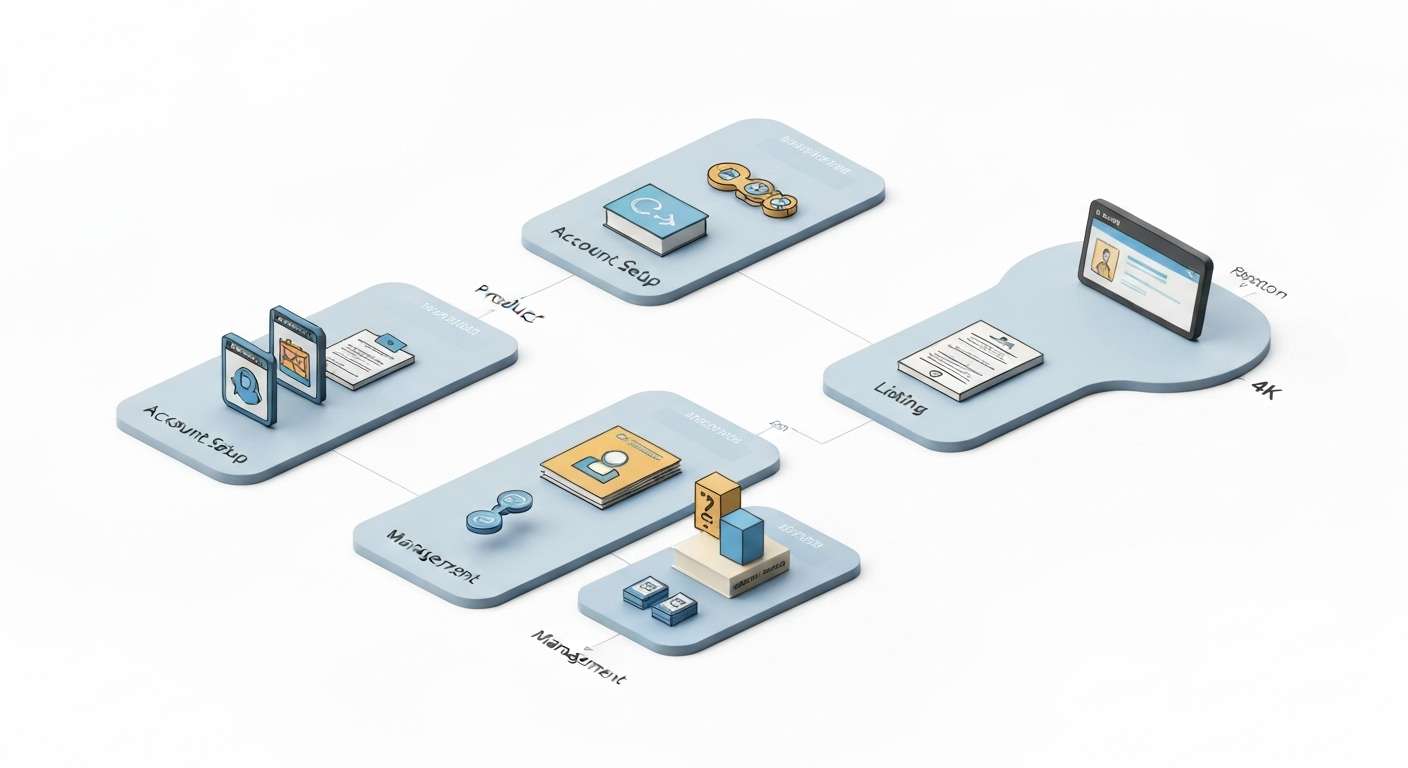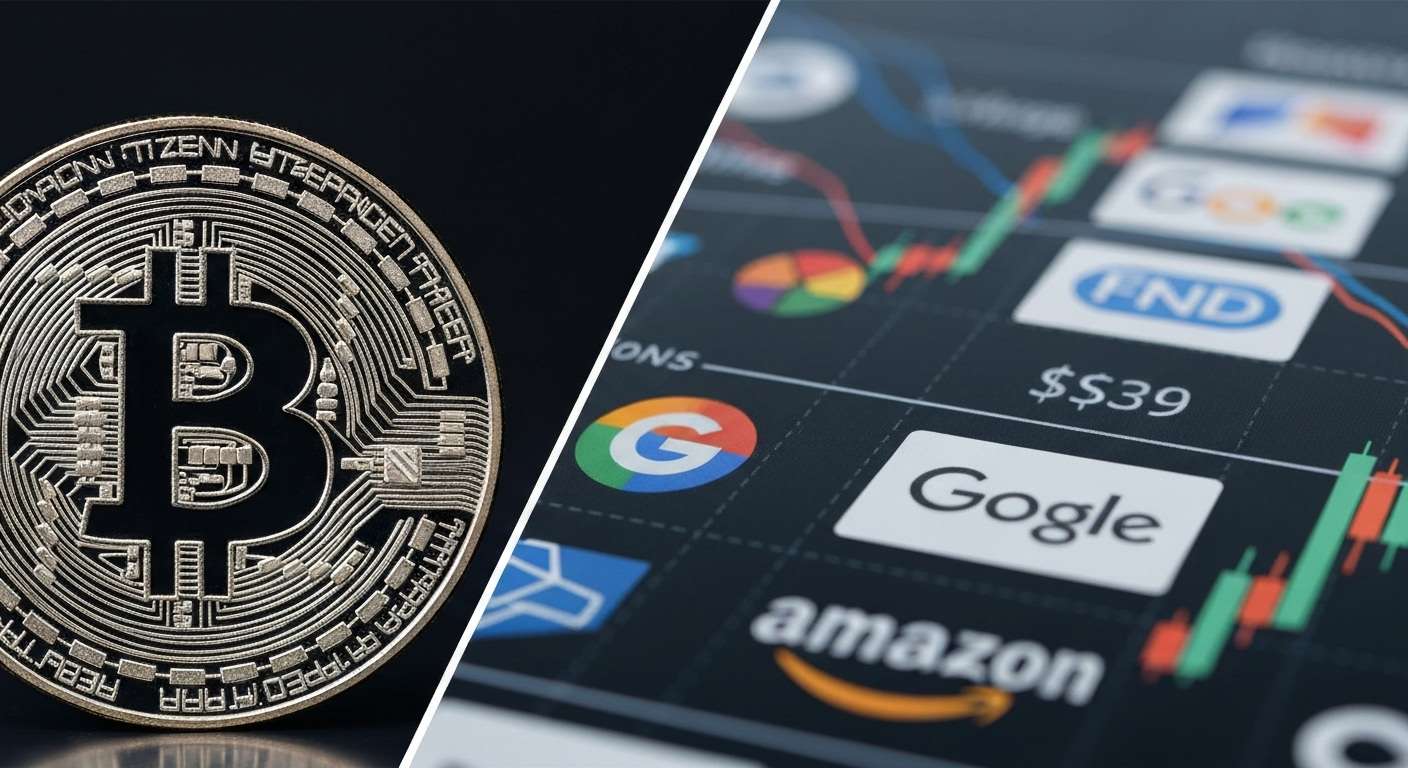Table of Contents
- Key Highlights
- Introduction
- Understanding Selling on Amazon Without Inventory
- Why Sell on Amazon Without Inventory?
- The Most Popular Methods to Sell on Amazon Without Inventory
- Legal and Policy Considerations ⚖️
- Step-by-Step Guide to Selling on Amazon Without Inventory 🛤️
- Conclusion 🏁
- Frequently Asked Questions
Key Highlights
- You can open an Amazon store and not keep items in stock. Ways to do this include dropshipping, print-on-demand, and selling digital products.
- The no-inventory model helps you lower startup costs. You will not be buying products at the start.
- A third party takes care of your fulfillment process. They ship items right to your customers. 🚚
- Dropshipping lets you sell products that are already in the supplier's catalogue. 🛒
- Selling digital products or offering print-on-demand is a good way to give people something special. 🎨
- This setup brings down your financial risk. It is good for anyone new who wants to get into e-commerce.
Introduction
Are you thinking about starting an e-commerce business on Amazon, but feel worried about the high startup costs of buying products right away? 🤔 You can build your online business without packing up boxes and keeping stock in your garage. There is an easier way to get started. You do not have to hold any stock to sell on Amazon. This means you can save a lot of money up front. It helps you avoid planning so much for storage and moving things from one place to another. 📏 This way, you can start with minimal risk and utilize online retail to grow. This could help you build a profitable online business. 🛍️
Amazon FBA, which stands for Fulfillment by Amazon, is a service where Amazon stores, packs, and ships your products to customers. So, you do not have to keep inventory at home. 🏠 With Amazon FBA, you can sell products without dealing with physical stock. This makes it a good choice for people who want to be online sellers with low startup costs. 👏
Understanding Selling on Amazon Without Inventory
Starting a business model on Amazon where you do not keep any inventory means you offer things for sale, but you do not store those items with you. You also do not handle the shipping for the products. This business model makes it easier for you to get started.
When customer orders come into your Amazon seller account, you send the details to another supplier. This supplier does all the work. 🔧 They get the items, pack them, and ship them right to the customer. Your main job is to take care of your listings and keep the customer happy with good customer service. 😊
Amazon FBA (Fulfillment by Amazon) is a common way to sell as an Amazon seller without dealing with your inventory. You send your products to Amazon's warehouse. When someone places an order, Amazon takes care of packing, shipping, and customer service for you. This setup lets sellers focus on making sales and marketing their products. 📊 Amazon handles the hard parts like shipping and other details from your Amazon seller account.
What Does “Selling Without Inventory” Mean?
At its core, selling without inventory means you can have an Amazon store, but you do not keep any physical inventory on hand. 🏪 You do not buy a lot of products or store them in a warehouse. Instead, you show items from a third-party supplier in your store. 🤝
This business model depends on a smooth fulfillment process. A customer makes an order. 🛒 You get their order details and share the shipping info with your supplier. Then, the supplier sends the product right to your customer. 🚚
You are the bridge between the buyer and the seller in this method. The big thing you do is share the product and help make the sale happen. 💼 You do not keep or send the product yourself. This means you do not have to handle inventory management, and you do not need to fix shipping troubles. So, selling without needing to keep products is a good option for people who are trying to start for the first time. 👌
How Does It Differ from Traditional Amazon Selling? ⚖️
The main difference from traditional selling on Amazon is that you look after your inventory. In traditional selling, people buy items before they sell them. 🛍️ They often buy a lot of products at one time. Then, they need to store the items. This can be in their place or at Amazon's fulfillment centers with the FBA program. They take care of the whole order fulfillment process, or they pay Amazon to handle it for them.
With the no-inventory model, you skip these steps. You do not need to put a lot of money into stock at the start. This lowers your financial risk by a big amount. This way makes things simple for you. But you lose some control over the supply chain and product quality. 🔍 That can hurt your profit margin and the customer experience at times.
Here’s a clear breakdown of the main differences:
| Aspect | Traditional Selling (with inventory) | Selling Without Inventory |
|---|---|---|
| Inventory Management | You must purchase, store, and manage your inventory. | No inventory is held by you; you rely on a third party. |
| Upfront Costs | Significant capital is needed to purchase stock upfront. | Very low or zero upfront costs for inventory. |
| Fulfilment Control | You have complete control over packing and shipping. | You have limited control as the supplier handles fulfillment. |
| Operational Complexity | More complex due to stock management and logistics. | Simpler operations, but highly dependent on supplier efficiency. |
Why Sell on Amazon Without Inventory?
 Starting an ecommerce business on Amazon without keeping stock is a good way to lower risk. You save on upfront costs and do not have to spend a lot of money right away. This makes it easier for new sellers to get started. 👋
Starting an ecommerce business on Amazon without keeping stock is a good way to lower risk. You save on upfront costs and do not have to spend a lot of money right away. This makes it easier for new sellers to get started. 👋
With this method, you can test different profitable products and try out new niches. You do not have to worry about having unsold goods. 🛑 This is a good way to create passive income and slowly grow the money you invest in the online business. You will learn how an online business works and still keep a good profit margin on every item you sell.
Key Advantages for New Sellers 👍
For people who are new to an online business, the no-inventory model on Amazon has many good benefits. This idea lets everyone start, even if they do not have a lot of money. If you want to know if this can help you get started faster, you should give it a try.
This model helps you grow and be flexible. You can test out different products and see the latest market trends. 📊 You do not have to worry about spending a lot of money like people do in the old retail way. Because you have this freedom, you can change your plans when you need to. You can put your time and money into important things, like customer satisfaction and marketing. 😊 If you pick a strong market and a good plan, you may make good money with this.
Here are some key advantages:
- Low Startup Costs: Start your online business without paying a lot. You do not need to have inventory, so the risk is lower.
- Reduced Overhead: You do not pay for warehouse fees. This makes inventory management much easier. 🏗️
- Flexibility: Add or remove products on your Amazon seller account when the market changes. Your seller account lets you do this with no trouble. 🔄
- Global Reach: Sell to people in any place. You do not have to ship the items to other countries on your own.
Keep in mind, the Amazon seller model lets you keep up with new market trends. It gives you more control over your seller account. You can also focus on customer satisfaction while having lower startup costs.
Potential Drawbacks and Risks ️
Selling without inventory can look like a good option, but there are some risks you have to watch out for. The main risk is that you depend on other companies to send your products to customers. 🤝 You do not have control over the product quality or over the fulfillment process because you are not the one to handle or check each item. This can lead to issues with customer feedback.
You should also know that there is tough competition in this area. A lot of people get started because it is easy, and that makes it hard to make a high profit. Also, you have to follow every Amazon rule in the right way, especially the dropshipping rules. If you do not do this, Amazon can stop your account.
Here are some risks you should keep in mind:
- Supplier Dependency: Many people will see your business based on how your supplier handles order fulfillment. So, their work has a big impact on your business.
- Quality Control Issues: If you do not get a chance to see and check the products, it is hard to know the product quality. Quality control becomes tough when you cannot inspect the items yourself. 🔍
- Lower Profit Margins: You will get less money from each sale because there are many sellers. Also, the supplier fees take off some of this profit.
- Policy Violations: If you do not follow Amazon’s rules for selling with no inventory, then you can run into big problems. This can affect your business.
Comparing No-Inventory vs. Traditional Selling Models ⚖️
When you think about your options, the choice is between having control and wanting things to be easy. If you choose traditional selling with Amazon FBA, you have your inventory. This lets you keep an eye on your products every day. It helps you do good quality control. Your customers get a steadier experience, since you look at each item before it goes out.
If you pick a no-inventory model, you will have an easier time getting things done. It is simple, and you can use product research to test many ideas. 🔍 You are not stuck with just one thing. But to do well in this way, you need to be quick with your pricing strategy. That is how you stay ahead and make money. You also have to trust your suppliers for good quality and on-time orders.
In the end, the best way to go ahead depends on what you have and what you want for your business. Traditional selling lets you get more earnings and gives you more control over your brand. A no-inventory setup is simple and keeps risk low when you want to start selling online. 👌 Both ways need good product research, and you should have a clear idea of the market.
The Most Popular Methods to Sell on Amazon Without Inventory
If you want to start on Amazon but do not want to keep any stock, there are some good ways you can do this. Each business model gives you a new way to earn money. You do not have to buy items at the start. The main ways you can use are dropshipping, print-on-demand, and selling digital products.
These options let you work with other companies that make and send out items for you. 🤝 With dropshipping, you sell goods that you find from other sellers. You can also use Amazon Merch if you want to make and sell your custom items. There is also a way to sell digital products, like e-books. One of these choices will fit you, depending on what you want and what skills you have.
Dropshipping on Amazon
Dropshipping is a well-known business model. In this setup, you do not keep any products with you. You work with a supplier or a maker. 🤝 They take care of the entire fulfillment process. You put their products in your Amazon store. When you get customer orders, you send the order details to your supplier. The supplier will ship the products right to the customer. 🚚 This way, you do not deal with the packing or sending part. The supplier handles the entire fulfillment process for your Amazon store.
This business model lets you sell many products, but you do not have to handle them yourself. You just need to focus on marketing, your Amazon store, and customer service. To make everything work the right way, you should find good suppliers. They have to ship the products on time and make sure all quality is the best.
Key aspects of dropshipping include:
- Low Capital Investment: You do not have to spend money on buying inventory, so this way to start the business is cost-effective.
- Wide Product Selection: You can sell many kinds of items from several suppliers. 🛒
- No Inventory Management: The supplier takes care of storage, shipping, and the whole fulfillment process through their fulfillment centers.
- High Competition: It is easy to enter the business, so there are many people competing in it.
Print-on-Demand Services (e.g., Merch by Amazon) 🎨
Print-on-demand (POD) helps content creators and designers sell items such as shirts and mugs. You do not have to keep any products in boxes or at home. 🏠 You use websites like Amazon Merch on Demand and Printify. All you do is upload your digital art to the site. Then, you pick what you want your art on, like shirts, mugs, and more.
When a buyer picks one of your designs, the POD service takes care of everything. They print the item, pack it, and ship it straight to the customer. 🚚 You get paid a royalty for each sale. It’s a good way for you to earn passive income. With print-on-demand, there are no upfront costs to worry about. You do not have to figure out shipping or handle any stock. This lets you launch a brand with your own style and custom products.
Key features of print-on-demand:
- Zero Inventory: The products get made only when a customer places an order. You do not have to keep anything in stock.
- Creative Freedom: You get to use your digital art and put your custom designs on many different things. 🖼️
- Automated Fulfillment: Amazon or another business takes care of making and sending out the items. You do not need to do this work. 🤖
- Passive Income Potential: Your designs keep bringing in money for you over time. This lets you earn passive income.
Selling Digital Products and E-books
Selling digital products is a great way to make money on Amazon. You do not need to keep any inventory for this. These digital products can be things like e-books, music, online courses, and digital art. 🎵 A lot of people use Amazon Kindle Direct Publishing, also called Amazon KDP. It makes it easy for authors to upload and sell their work. This is one great way that many people use to get their digital products out to others.
With Amazon KDP, you can put your writing and the cover up for sale. You pick the price for it. 💲 Then, people from all over the world can get your product. You have to make it just once. After that, it will give you passive income as more people buy it. You do not need to pay extra for packing or sending each order.
Benefits of selling digital products:
- No Physical Stock: All items are digital. Customers get to download them right away. 📥
- High-Profit Margins: You do not need to pay to make the product or ship it, so you may keep more profit.
- Create Once, Sell Forever: You only have to make a digital product once. It can earn money for you for many years. ♾️
- Global Distribution: With platforms like Kindle Direct Publishing and amazon kindle direct publishing, you can reach people everywhere in the world.
Legal and Policy Considerations ⚖️
When you want to sell on Amazon without any inventory, you must know and follow the rules set by Amazon. The company is strict about its policies to make sure customers get a good experience. 😊 If you do not follow these rules, your seller account can be suspended.
Most legal trouble can come up when you do dropshipping or let someone else handle order fulfillment for your orders. You need to make sure what you do follows Amazon's terms of service. This will help you have a business that lasts a long time and stays within the rules. Next, we will look at the main rules you need to know.
Amazon’s Rules for Dropshipping and No-Inventory Models
Amazon lets people do dropshipping. But you must stick to its strict rules. The main rule is you have to be the seller of record on all paperwork. 📄 Your name and your branding must be what your customer sees. The name of your supplier should not be shown.
If you do not do this, your Amazon seller account could be at risk. When you send products in someone else's packaging or with their invoice, it is a direct mistake. Amazon wants people to know who they buy from at all times, so the customer experience stays clear. This way, everything stays simple for their customers, and it helps sellers keep their seller account safe.
To keep your Amazon seller account safe and follow the rules, you must:
- Be the seller of record for all products.
- Show your name as the seller on every packing slip, invoice, and all other papers that go with the product.
- Take care of customer returns yourself, and handle all steps. 🔄
- Keep to every part of your seller agreement and all other Amazon rules. 👌
By doing these steps, you can make sure people feel good when they buy from you. It also helps you keep your seller account safe.
Common Pitfalls and How to Avoid Them ️
One big risk in the no-inventory model is that you have less quality control. You do not get to see the product before it goes to the customer. 🔍 You must trust the supplier to send items that are good. If product quality is not good, there will be bad customer feedback. This can hurt the reputation of your store very fast.
There is one more thing that many face. The order fulfillment centers can sometimes be a big problem. There are times when they ship out late. At other times, they may send the wrong items. 🚚 This upsets customers. It can also put you and your business in trouble with Amazon’s rules for order fulfillment. You have to make sure to pick the right partners if you do not want these problems.
Here’s how to avoid common pitfalls:
- Vet Suppliers Carefully: It is important to check if the partner is reliable. See that they give you good product quality.
- Place Test Orders: You need to buy products on your own. This helps you know what your customers get and how fast it comes. 🛒
- Maintain Clear Communication: Always let your customers know what is happening with their orders. If there is any delay, say it right away. 📞
- Monitor Customer Feedback: Read and watch customer feedback. Look at reviews and what people say. This helps you spot problems with your supplier or product quality fast. 📊
Step-by-Step Guide to Selling on Amazon Without Inventory 🛤️
 You can be an Amazon seller, and it is not hard to start. Even if you do not have inventory, you still can get going. First, make your Amazon seller account. After that, you need to pick a selling plan that works for you. Then, choose a way to sell with no inventory. Next, look for profitable products that you can offer people.
You can be an Amazon seller, and it is not hard to start. Even if you do not have inventory, you still can get going. First, make your Amazon seller account. After that, you need to pick a selling plan that works for you. Then, choose a way to sell with no inventory. Next, look for profitable products that you can offer people.
Next, use Seller Central to set up your product listings. You have to manage your store and also keep track of order fulfillment. 📊 Open your central account and put in your bank account details to get started. This step-by-step guide will take you from the beginning to launching and promoting your new business. The guide helps you learn how to make your store work and grow as time goes by.
Step 1: Set Up Your Amazon Seller Account
The first thing you need to do to begin your Amazon seller journey is set up your Amazon seller account. Go to sell.amazon.com and click the ‘Sign Up’ button. They will ask for some basic info, such as details about your business, your bank account so you can get paid, and a credit card the site can use for charges.
When you sign up, you need to choose the selling plan that fits your needs. If you want to sell fewer than 35 items in a month, the Individual plan might be right for you. 👤 This plan comes with fewer tools. If you want to grow your Amazon business, you should choose the professional plan. That plan has a set monthly fee. You will get more features for your seller account, like extra reporting, access to some limited categories, and powerful tools to help you use your account and grow.
After you set up your Amazon seller account, you can start using Seller Central. This is the place to manage your seller account. 📊 In Seller Central, you can add new product listings and keep an eye on your numbers. You can also chat with customers and work on your Amazon business every day.
Step 2: Select Your Preferred No-Inventory Method 🔍
After you set up your seller account, you need to choose a business model. This choice should fit what you know, what you like to do, and what you want for your business. If you do not want to keep any stock, you can pick from three main ways to do this. You can try dropshipping, print-on-demand, or selling digital products.
If you are good at meeting new people and working with others, dropshipping could be a good business model for you. In this business model, you sell many kinds of products, but you do not have to keep them. You only need to find the right people to team up with. If you like to design or make art, print-on-demand is another business model. It lets you earn money by selling your merchandise. There is no up-front cost, and you can start this model easily.
People who write and make things like lessons often do well when they sell digital products. A place like Amazon KDP is great for this. You can get good money and make sure you keep earning for years. It is best to take time to think about every business model you find. After you do that, pick the one that works for you and fits what you want.
If you want to earn money with digital products, opening a seller account can be a good way to start. A lot of content creators now use a business model that helps them make passive income from things like e-books, guides, and designs. They put their work on places like Amazon KDP, which lets people sell digital products with little effort. This means you can get paid while you do other things. The steps to get started are easy, and many people find that selling digital products is a simple way to use their skills for extra income.
Step 3: Research Profitable Niches and Products
Even if you do not have any products in stock, you need to do product research. Your success will be in picking profitable products. It is good to know what people want and need now. You can use market research tools for this. These tools help you see market trends. They let you see what customers are looking for and how much other sellers are out there. With this, you get to know more about the market and how to choose the best products.
Think about the people you want to sell to. Try to find niche markets where buyers keep coming back. 🛒 Many niche products do not have a lot of competition. So, you can have a better spot in the market. You can use Helium 10’s Black Box for help. Helium 10’s Black Box lets you see many Amazon products. You can find items that sell well and don’t have much competition. Make sure to focus on your target audience when you look for these products.
You should check your ideas before you spend your time and energy on them. It is important to know if people want to buy what you offer. This matters whether you want to sell tech gadgets with dropshipping, make t-shirts for hobby lovers, or write an e-book for a group of professionals.
Step 4: Create and Optimize Product Listings
After you choose what to sell, the next step is to write good product listings. A strong listing can help you get more buyers. It can also help you move up in Amazon search results. 🔍 Your title needs to be simple and let people know what the product is. Be sure to use your most important and relevant keywords in the title.
In your bullet points and the product description, you need to show the best features and benefits. Use the right keywords in a way that fits well with the text. Do not put too many keywords, or your listing will not read well. 📊 Make sure the images you use are high-quality. These can help people choose what to buy. If you are dropshipping, ask your supplier for good images. For print-on-demand, try using a mockup generator.
Next, you need to see that your pricing strategy is smart. Add up all costs, such as what you pay your supplier, and count Amazon’s referral fees and other charges. 💲 This will help you keep a good profit margin. A strong product listing, good product quality, and good customer service will help you get more sales. The product listing should be optimised well to increase conversions, so make sure you get all of these things right.
Step 5: Launch, Promote, and Manage Your Store
With your listings now live, it is time to get people to visit your store and start managing it. A good way to show what you are selling will help you reach more potential customers. 📣 You can use Amazon ads, like Sponsored Products, so that more people see your products in the marketplace. Sharing your products on social media or posting them on a blog can also work well, especially if you use the affiliate models or sell print-on-demand products.
When you start to get orders, be sure to focus on customer satisfaction. Check customer feedback often. 📊 You need to answer questions quickly. Good reviews matter a lot. They help people trust you and boost your seller rating. Shivali Patel, the Senior Brand Evangelist at Helium 10, says, “Transparent communication will form the backbone of your success.”
With Seller Central, you get tools that help you see how you are doing. The tools are there to help you find ways to get better. 🔧 You can keep working to make your prices right. You can use better keywords. You can work on how you show your products to people. This helps your business grow and do well on Amazon, where there are many sellers. If you use tools in Seller Central, it can make a big difference for you.
Conclusion 🏁
Selling on Amazon without holding products yourself lets people test out new business ideas. You can get started by trying dropshipping, print-on-demand, or digital products. These ways let you start with low upfront costs. You must follow Amazon's rules and be careful of any problems that come up with these options. If you pick a smart plan, do your research, and market your items well, you can make good money in this area. Remember, every person who succeeds takes that first step. Why not take your step now? 👣 If you want to find out more and start selling, get a free consultation to help you learn the steps!
Frequently Asked Questions
Is it easy for beginners to start selling on Amazon without inventory?
Yes, this is one of the easiest ways for people new to online business to start. The business model helps because you do not need to spend much to get going. There are no inventory worries. Setting up an Amazon store and a seller account is simple. But, to do well, you still need to choose the best business model and spend time on research.
Can I make significant money selling on Amazon without owning inventory?
Yes, you can make good money and have a way to get passive income from this. Your profit margin comes from how you set your pricing strategy, what things you decide to sell, and the fees that come from the marketplace. If you give good customer service, you can stand out. This can help you build a business that makes a good amount for you.
Are there any legal risks when selling on Amazon without inventory?
The biggest risk is breaking Amazon's rules, especially when it comes to dropshipping. You have to follow all the rules about order fulfillment and give a good customer experience. This is important so your seller account does not get suspended. Be sure to check the policies in Seller Central often to make sure you stay within the rules.
What tools can help me manage a no-inventory Amazon business?
You can use tools for market research to get better results. Helium 10 is good for this and can help add keywords to your product listing. 🔍 Seller Central from Amazon is the main place to handle sales. You use it to read customer feedback as well. For checking your money and costs, Synder is a helpful software. It lets you see how much you make and spend. The software can also save you time by doing some work for you.
Thank you for reading! If you found this article helpful, please share it with others who might benefit. And remember, your journey is just beginning. Stay curious, stay faithful, and keep shining your light!














